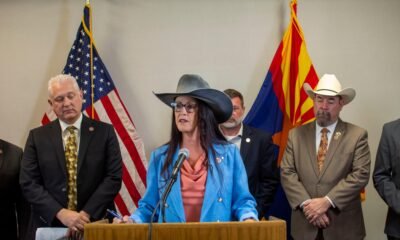AHCCCS
Tragic Deaths in AZ Sober Living Homes Highlight Medicaid Fraud Response Failures

At least 40 Native American residents in sober living homes and treatment facilities across the Phoenix area have died amidst a significant Medicaid fraud investigation that specifically targeted Indigenous peoples grappling with addictions.
The fatalities, primarily linked to substance abuse, occurred between spring 2022 and summer 2024, as documented by the Maricopa County Office of the Medical Examiner. A concerning pattern emerged: over half of these deaths happened while officials ignored repeated calls for enhanced oversight, contributing to a surge in fraudulent recruitment into fake treatment programs.
Even after Arizona officials launched an extensive investigation in May 2023, patients continued to die. The breadth of the fraud had become so dire that subsequent efforts focused on halting Medicaid reimbursements to behavioral health organizations implicated in wrongdoing.
The Arizona Health Care Cost Containment System (AHCCCS) has estimated that the fraudulent activities drained taxpayers of approximately $2.5 billion. Notably, it has yet to release specific figures correlating the fraud with the associated deaths.
Documentation from the Arizona Center for Investigative Reporting and ProPublica reveals that, across several administrations, officials repeatedly failed to act on the evidence indicating that rampant fraud was endangering the very Native Americans reliant on these state services.
A class-action lawsuit recently filed by families of the deceased highlights a broader pattern of negligence, citing at least three individuals whose deaths were not directly linked to the facilities in the medical records but were nevertheless tied to the same disastrous oversight.
Governor Katie Hobbs, who took office in January 2023, has laid blame on her Republican predecessor, Doug Ducey, for not adequately addressing the scale of the fraud during his administration. However, investigations have revealed that key reforms that could have mitigated the issue faced delays under Hobbs’ appointed AHCCCS leadership.
Communities affected by this crisis, including advocates like Reva Stewart, have suggested that the actual death toll could be significantly higher than reported. Stewart estimates that hundreds have succumbed due to the fallout from these compromised programs. Some individuals reportedly went missing or became homeless as facilities shut down in the wake of the fraud investigation.
Lorenzo Henry, a member of the San Carlos Apache Tribe, shared his personal tragedy, recounting how he lost family members while trying to navigate inadequate treatment programs. “We need accountability from AHCCCS for enabling this crisis,” he said.
Among the victims was Jeffrey Hustito, a 43-year-old from Zuni Pueblo, who sought treatment for alcoholism. His challenges began in 2021 when he entered a program that eventually spiraled into a disorganized network of care that left him wandering from facility to facility.
Despite initial optimism, Hustito’s condition deteriorated. His family described a heartbreaking timeline, culminating in his death on December 27, 2022, at a sober living home, where inadequate supervision allowed intoxicants to permeate the environment.
Investigations reveal the fraudulent practices thrived due to the lack of stringent regulations within the American Indian Health Program, which enabled providers to establish their own reimbursement rates. This environment led to vast overbilling, sometimes totaling up to $60,000 for a single session.
The history of misconduct extends back to 2019, reflecting a systematic failure by policymakers. Despite indications of severe dysfunction, including rocky oversight and operational inconsistencies, substantive reform was repeatedly stalled.
Following a surge in reimbursement claims, AHCCCS faced a deluge of accusations regarding the exploitation of vulnerable populations. Allegations spread that treatment facilities were practicing aggressive recruitment tactics, even sending vans to gather potential clients from reservations. State officials initially struggled to grasp the full scope of the crisis.
In a climate of negligence and delay, the tragic fate of individuals like Hustito emphasizes the urgent need for accountability and reform within Arizona’s Medicaid system, particularly as Native communities navigate the complex landscape of addiction and recovery. Advocates are calling for comprehensive changes to ensure such tragedies do not recur in the future.
As investigations continue, the families grieving lost loved ones await acknowledgment and justice for the systemic wreckage left in the wake of these fraudulent practices.






![Katrina Woods stands next to her attorney, Ron Reyna, during her arraignment at Pinal County Superior Court on May 9,. 2025. Top: Snippets from court records show what Woods pleaded to in her county case. [David Iversen/Pinal County Superior Court/graphic]](https://arizonanews.org/wp-content/uploads/2025/06/FEMA-Fraud-Suspect-Katrina-Woods-Shocks-with-Plea-Deal-Now-400x240.jpg)
![Katrina Woods stands next to her attorney, Ron Reyna, during her arraignment at Pinal County Superior Court on May 9,. 2025. Top: Snippets from court records show what Woods pleaded to in her county case. [David Iversen/Pinal County Superior Court/graphic]](https://arizonanews.org/wp-content/uploads/2025/06/FEMA-Fraud-Suspect-Katrina-Woods-Shocks-with-Plea-Deal-Now-80x80.jpg)










